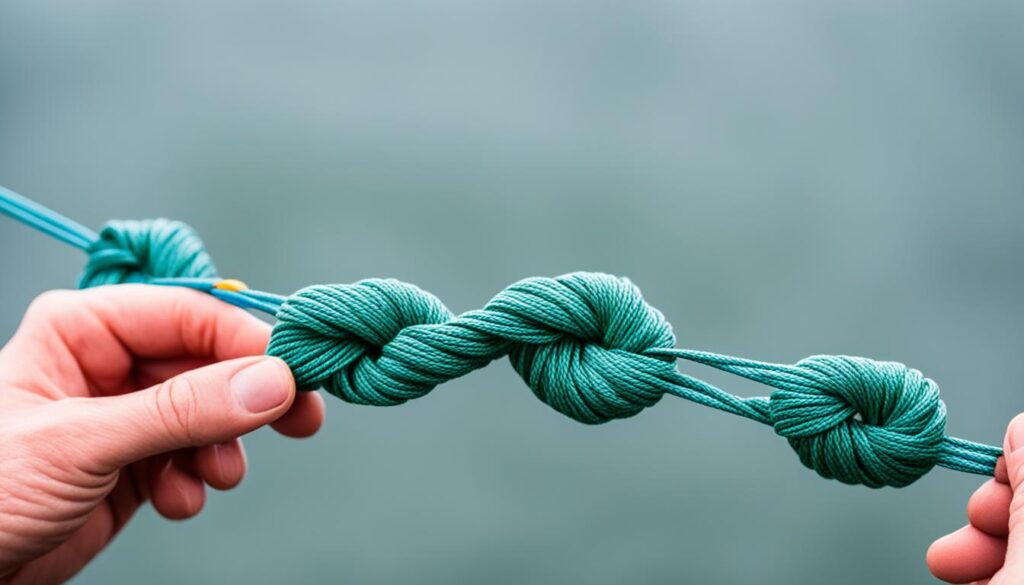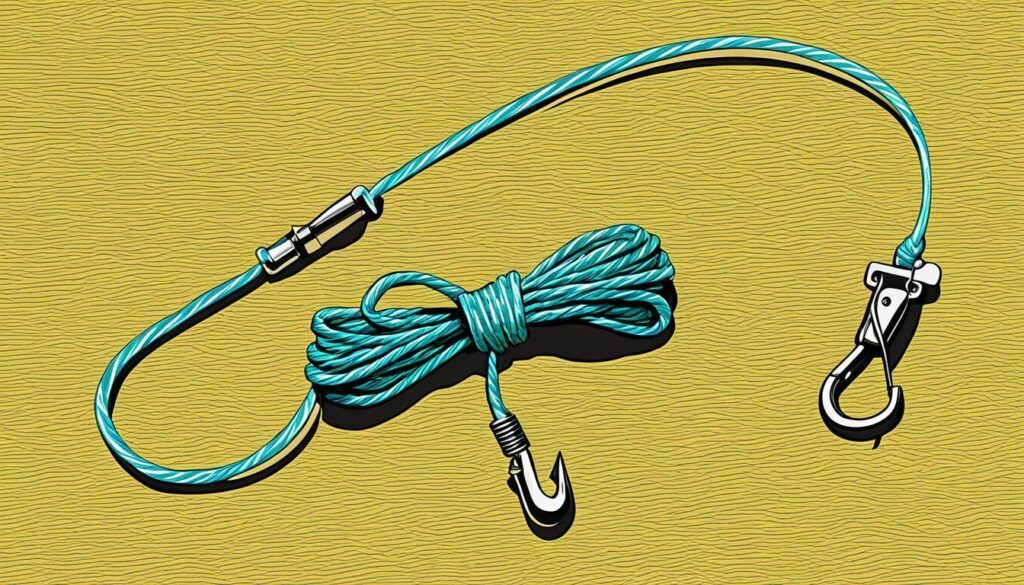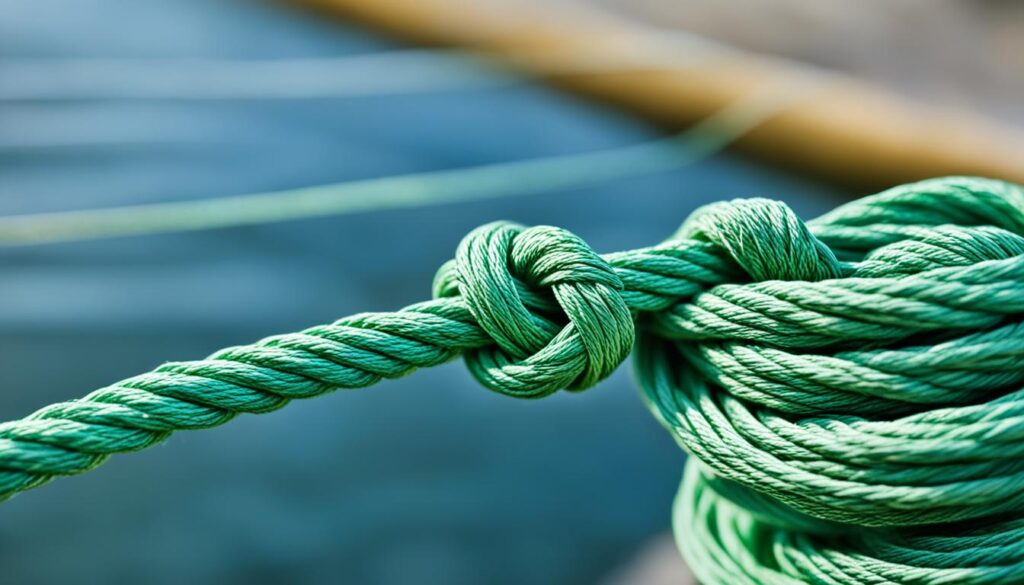If you love fishing, knowing the proper knots is vital. You’ll need them to join lines, make loops on lures, or tie your hook. The right fishing knots mean your line won’t break easily, and you might snag that fish of a lifetime.
In this piece, we list the top fishing knots for you to learn. These knots are great for bass fishing and many other kinds. They have been tested and proven. With our guide, you’ll be tying knots like a pro, giving you a better shot on your next fishing trip.
Key Takeaways:
- Knowing a variety of fishing knots is essential for every angler.
- Tying a good knot is crucial to keep your fishing line strong.
- The best fishing knots are very strong and don’t slip.
- Some top fishing knots include the Palomar knot, Improved Clinch knot, Uni knot, San Diego Jam knot, and Snell knot.
- Learning these knots will improve your fishing and make sure your catches stay hooked.
The Palomar Knot
The Palomar knot is a simple yet very strong fishing knot. It’s a must-know for all anglers. This knot is easy to learn and is a favorite amongst fishing fans. Whether you’re new to fishing or have years of experience, knowing this knot will help you a lot.
This knot doubles the line over the hook’s eye. It makes a secure joint, especially with fluorocarbon line. If you tie it right, your line won’t slip or break when under pressure.
Tying the Palomar knot is easy. Here’s how:
- Double about 6 inches of line and pass it through the eye of the hook or lure.
- Tie a simple overhand knot, creating a loop with both ends of the line.
- Pass the loop over the hook or lure, ensuring that the tag end is hanging loose.
- Moisten the knot with saliva or water to reduce friction and prevent damage to the line.
- Hold the tag end and main line, then slowly pull them in opposite directions to tighten the knot.
- Trim any excess line to ensure a clean finish.
Make sure to practice tying this knot before you go fishing. Soon, you’ll be able to tie it with ease and speed.
When gearing up for your next fishing trip, remember the Palomar knot. It’s a strong, reliable knot that will help you catch more fish.
The Improved Clinch Knot
The Improved Clinch knot is excellent for small fishing lines. It’s key for both new and expert anglers. It’s easy to learn and very useful.
Here’s how to tie it:
- Pass the line through the hook’s eye.
- Wrap the line around itself 5 to 7 times.
- Thread the end through the loop by the hook’s eye.
- Then, through the new loop you made.
- Wet the knot a bit for a tight finish.
- Finally, pull both ends to secure the knot.
- Cut off the extra line.
This knot creates a firm link between your hook and line. It’s easy to do and can handle pulling fish.
Practice to get it just right. Learning this knot well will help you a lot in fishing.
The Advantages of Using the Improved Clinch Knot
Here’s why the Improved Clinch knot is so valuable:
- Strength: It’s very strong. It keeps your line and hook together even when catching big fish.
- Easy to Tie: It’s simple and quick to do. Perfect for those starting out in fishing.
- Universal Usage: This knot works with many types of lines. You can trust it with different fishing needs.
Knowing this knot boosts your fishing confidence. It ensures your gear stays connected even during tough catches.
| Knot | Strength | Difficulty | Best Used With |
|---|---|---|---|
| Improved Clinch Knot | High | Easy | Monofilament, fluorocarbon, and braided fishing lines |
| Palomar Knot | High | Easy | Monofilament, fluorocarbon, and braided fishing lines |
| Uni Knot | High | Medium | Monofilament, fluorocarbon, and braided fishing lines |
| San Diego Jam Knot | High | Medium | Monofilament, fluorocarbon, and braided fishing lines |
The Uni Knot
The Uni knot is a must-have for any fisher. It’s great for many tasks like attaching hooks and lines. This knot works well with light and heavy lines, making it a top choice for anglers around the world.
To tie the Uni knot:
- Pass the line through the eye of the hook or lure.
- Create a loop by overlapping the tag end over the standing line.
- Make multiple wraps around the doubled line and through the loop, forming a series of coils.
- Moisten the knot with saliva or water to reduce friction as you tighten it.
- Hold the coils and pull the standing line to tighten the knot.
- Slide the knot down towards the eye of the hook or lure.
- Trim any excess line.
The Uni knot is known for its tight grip. It keeps your bait or hook secure in the water. Fisherpeople love it for how simple and effective it is.
Benefits of the Uni Knot:
- Strong and reliable connection
- Works well with both small and heavy lines
- Versatile – can be used for various fishing applications
- Easy to tie with practice
“The Uni knot is my go-to knot for joining lines of different strengths and securing my hooks. It has never let me down, even when battling large fish.” – Mark Davis, Professional Angler
Learning the Uni knot will boost your fishing skills. Keep practicing until it’s second nature. Once you’ve got it down, it’ll be an essential tool for your angling adventures.

The San Diego Jam Knot
The San Diego Jam knot is a favorite of pro anglers. They love it for its strength and quick tying. It’s perfect if you want your lure or hook secure fast.
It’s especially good for connecting your line to a hook or swivel. Its strength keeps your bait or lure steady, even with a big fish pulling.
The steps to make this knot are easy:
- Step 1: Guide the line through your hook or swivel’s eye.
- Step 2: Double the line to make a loop, keeping some end free.
- Step 3: Put the loop and end through the eye again.
- Step 4: Wrap the end around the line and through the loop.
- Step 5: Dampen the knot and pull both ends slowly to tighten it.
- Step 6: Cut off any extra end to finish.
Getting good at this knot takes practice. Keep at it, and soon you’ll tie it swiftly and surely each time you fish.
If you want to see how to do the San Diego Jam knot, check the image below:

Tips for Tying the San Diego Jam Knot:
- Wet the knot before pulling to avoid line damage.
- Keep the wraps tidy and tight for a strong hold.
- Always check the knot by pulling firmly before casting.
| Advantages of the San Diego Jam Knot | Disadvantages of the San Diego Jam Knot |
|---|---|
| Strong and reliable connection | Can be challenging to tie correctly at first |
| Quick and easy to tie once you get the hang of it | May slip or untie if not properly tightened |
| Versatile knot that can be used for various fishing applications | May create bulk on thinner lines |
The Snell Knot
The Snell knot changes the game when you need to flip hooks into dense cover. It keeps your hook secure and increases your chance of catching a fish by its design. This knot is great for certain fishing situations.
Learning to tie a Snell knot is a valuable skill that can boost your fishing. It works especially well when you need to keep your hook close to the fish.
How to Tie the Snell Knot
It’s not hard to tie a Snell knot if you follow these instructions:
- Start by threading your fishing line through the hook’s eye, leaving a long tag end.
- Hold both the tag and main line together to form a loop.
- Wrap the tag end around the hook’s shank and the main line tightly.
- Do this about 5 to 7 times, keeping the line tight as you work.
- Feed the tag end through the loop you formed in step 2.
- Wet the knot with water or saliva. This helps it tighten without damage.
- Slowly pull the main line and the tag end opposite directions to secure the knot evenly.
- Trim the extra tag end, but leave a little bit for additional strength.
Keep practicing the Snell knot to become fast and proficient. Good technique and practice are the keys to a strong Snell knot game.
“The Snell knot is key for turning those hard-to-catch fish with straight shank worm hooks in thick cover. It ups your chances and keeps your line strong. Make sure you know this knot for better fishing.”
| Knot Name | Strength | Ease of Tying | Versatility |
|---|---|---|---|
| Snell Knot | High | Moderate | Niche use for flipping worm hooks |
| Palomar Knot | High | Easy | General purpose knot |
| Improved Clinch Knot | Medium | Easy | Securing line to hooks or lures |
| Uni Knot | High | Moderate | Joining lines, snelling hooks |
| San Diego Jam Knot | High | Moderate | Securing lures or hooks |
Understanding the Snell knot is a step towards better fishing. Practicing it will help you do well in tough fishing spots and aim for big catches.
Conclusion
Every angler needs to know good fishing knots. These knots are crucial for different fishing situations. They make sure your bait or hook stays on your line. The best fishing knots are strong, don’t slip, and are easy to tie. By mastering these knots, you’ll get better at fishing.
A fishing knot guide is a great tool. It shows you how to tie these critical knots. With clear steps and pictures, learning is easier. Don’t forget that the more you practice, the better you’ll get at confidently tying knots.
Knowing these knots is useful for anyone who loves fishing, from starters to experts. So, get your fishing gear ready. Use the fishing knot guide and start practicing. Soon enough, you’ll be tying knots like a pro. This will help make your fishing trips more successful.
FAQ
What are the best fishing knots every angler should know?
The top fishing knots to know are the Palomar, Improved Clinch, Uni, San Diego Jam, and Snell knots.
How do you tie the Palomar knot?
To tie the Palomar knot, fold the line in half and loop it through the hook’s eye. Then, tie an overhead knot with the loop and end of the line. Pull it tight.
How do you tie the Improved Clinch knot?
For the Improved Clinch knot, thread the line through the hook’s eye. Wrap the line around itself 5-7 times. Pull the tag end back through and tighten.
How do you tie the Uni knot?
To make a Uni knot, thread the line through the hook and double back. Loop the tag end and main line together. Wrap the tag end through the loop and main line. Pull to tighten.
How do you tie the San Diego Jam knot?
The San Diego Jam knot starts by directing the line through the hook’s eye. Create a loop then wrap that loop around the line and itself several times. Pull the line to tighten.
How do you tie the Snell knot?
To tie the Snell knot, pass the tag end through the hook’s eye from the back. Wrap it around the shank and main line. Pull the tag end through the formed loop and tighten.
Why is it important to tie a good fishing knot?
Tying the right fishing knot ensures your line is strong and durable. A good knot prevents breakage, enhancing your fishing success.
What are some tips for tying stronger fishing knots?
To make your fishing knots stronger, tie them straight, wet the line, tighten slowly, match the knot’s strength, and keep wraps neat.
How can learning different fishing knots improve my fishing game?
Mastering various knots helps you in different fishing situations, keeping your gear secure. This skill boosts your fishing success and improves your angling.
